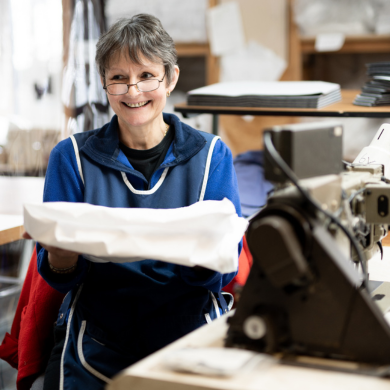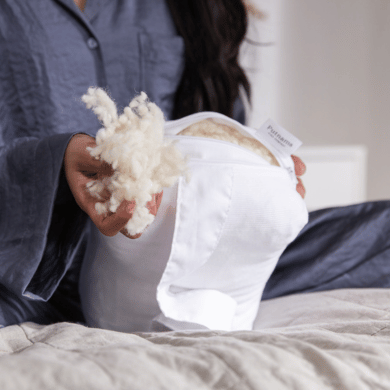
Linderung von Bandscheibenschmerzen im Sitzen und Schlafen
Bandscheibenschmerzen können unglaublich frustrierend sein. Für viele sind sie eine Folge des heutigen sitzenden Lebensstils, können aber auch die Folge von zu viel Sport oder einfach nur Pech sein. Die gute Nachricht? Mit der richtigen Behandlung und den richtigen Produkten können Sie Linderung finden.
Wenn Sie zu den 1 von 3 Menschen in Großbritannien gehören, die unter Bandscheibenschmerzen leiden, sind wir hier, um Ihnen Linderung zu verschaffen, und zwar hier und jetzt!
Dieser Leitfaden gibt Ihnen praktische Tipps zur Linderung von Bandscheibenschmerzen im Sitzen und Schlafen und verhilft Ihnen zu einem angenehmeren Leben.
Bandscheibenschmerzen im Rücken verstehen
Anatomie der Wirbelsäule und der Bandscheiben
Ihre Wirbelsäule ist eine komplexe Struktur aus Wirbeln, Bandscheiben, Nerven und Stützgewebe. Die Bandscheiben sind kissenartige Polster zwischen den Wirbeln, die als Stoßdämpfer fungieren und Flexibilität und Beweglichkeit ermöglichen. Sie haben eine robuste, faserige Außenschicht und einen gelartigen Kern. Bei Problemen ist es wichtig, das Problem sofort zu beheben, um wiederkehrende Schmerzen zu vermeiden.
Obwohl für Rückenverletzungen viele verschiedene Behandlungsmethoden empfohlen werden, ist es wichtig, sicherzustellen, dass die richtige Ruheumgebung zur Verfügung steht, damit sich Ihre Muskeln und Bänder vollständig erholen können.
Putnams bietet eine große Auswahl an Kissen, darunter Kissen für Bandscheibenvorfälle, Keilkissen für Bandscheibenvorfälle und Nackenhernienkissen. Alle Kissen bieten die perfekte Umgebung für die Genesung.
Häufige Ursachen für Bandscheibenschmerzen
Bandscheibenschmerzen können verschiedene Ursachen haben, darunter eine schlechte Körperhaltung, Bewegungsmangel, plötzliche Bewegungen und Verletzungen. Langes Sitzen und falsche Hebetechniken können die Wirbelsäule belasten und zu Bandscheibenverschleiß oder -vorfällen führen.
Das Verständnis dieser Ursachen ist für die Vorbeugung und Behandlung bandscheibenbedingter Rückenschmerzen von entscheidender Bedeutung.
Symptome und Diagnose
Typische Symptome von Bandscheibenschmerzen
Menschen mit Bandscheibenschmerzen leiden häufig unter starken oder chronischen Schmerzen, Kribbeln, Taubheitsgefühlen oder Schwächegefühlen im betroffenen Bereich. Je nachdem, welche Bandscheibe betroffen ist, können die Schmerzen in andere Körperteile wie Beine oder Arme ausstrahlen.
Bedeutung einer professionellen Diagnose und Behandlung
Wenn Sie den Verdacht auf ein Bandscheibenvorfall haben, ist eine professionelle Diagnose und Behandlung unerlässlich. Ein Arzt kann körperliche Untersuchungen, bildgebende Verfahren und andere diagnostische Verfahren durchführen, um die genaue Ursache Ihrer Schmerzen zu ermitteln und geeignete Behandlungsmöglichkeiten zu empfehlen.
Lösungen zur Linderung von Bandscheibenschmerzen
Ergonomisches Sitzen und richtige Haltung
Eine der effektivsten Möglichkeiten, Bandscheibenschmerzen zu lindern, ist die Investition in ergonomische Sitzmöbel und die Einhaltung einer korrekten Haltung. Stühle mit Lordosenstütze , Höhenverstellung und Liegefunktion können die Belastung Ihrer Wirbelsäule deutlich reduzieren.
Auch Fußstützen und regelmäßige Dehnpausen können hilfreich sein. Mit Bandscheibenkissen und einer Reihe weiterer speziell entwickelter Putnams-Produkte können Sie Ihr Leben ein wenig schmerzfreier gestalten.
Stützende Kissen und Matratzen
Stützende Kissen und Matratzenauflagen spielen eine wichtige Rolle bei der Linderung von Bandscheibenschmerzen. Memory Foam- oder orthopädische Kissen bieten die nötige Unterstützung für Nacken und unteren Rücken. Ebenso kann eine Matratzenauflage bei einem Bandscheibenvorfall für eine korrekte Ausrichtung der Wirbelsäule im Schlaf sorgen.
Schauen Sie sich hier die Produktpalette von Putnams mit ihren hervorragenden Optionen an .
"Bett-RückenstützkissenAnfangs fühlte es sich seltsam an, damit zu schlafen, aber ich habe mich schnell daran gewöhnt, und durch die Unterstützung meines Rückens schlafe ich viel besser. Wenn ich morgens aufwache, schmerzt mein Rücken nicht mehr. – Jane M
Spezielle Hilfsmittel und Produkte zur Linderung
Kissen, Polster und Matratzenauflagen
Spezielle Bandscheibenvorfallkissen, Bandscheibenauflagen und Matratzenauflagen können gezielt Schmerzen im Rücken lindern. Produkte wie das Keilkissen für Bandscheibenvorfälle und das Nackenhernienkissen stützen die Wirbelsäule und reduzieren den Druck auf die betroffenen Bandscheiben. Die Anwendung dieser Produkte muss unter ärztlicher Anleitung Ihres Hausarztes erfolgen.
Auch die Verwendung eines Kissens bei einem Bandscheibenvorfall oder einer festen Matratze bei einem Bandscheibenvorfall kann den Komfort und die Schmerzlinderung deutlich verbessern.
Funktionen und Vorteile empfohlener Produkte
Achten Sie bei der Produktauswahl auf Eigenschaften wie Memory-Schaum, einstellbare Härte und ergonomisches Design. Diese Eigenschaften gewährleisten optimale Unterstützung und Anpassungsfähigkeit an die Bedürfnisse Ihres Körpers. Beispielsweise verfügt das Putnams Duo Auto-Rückenstützkissen über Memory-Schaum, der sich der natürlichen Krümmung Ihres Rückens anpasst und sowohl Komfort als auch Stabilität bietet – die perfekte Polsterung bei einem Bandscheibenvorfall.
"Duo Auto-Rückenstützkissen - Memory FoamIch habe dieses Stützkissen für meinen Mann gekauft, da er immer wieder Rückenschmerzen hatte. Schon nach wenigen Tagen bemerkte er einen deutlichen Unterschied, sowohl im Auto als auch am Schreibtisch. Heute haben wir ein zweites bestellt, um es an seinem Schreibtisch aufzustellen. – Jacqui P
Änderungen des Lebensstils und Übungen
Praktische Tipps zur Verbesserung der Körperhaltung
Eine falsche Körperhaltung ist eine der Hauptursachen für Bandscheibenschmerzen.
Einfache Anpassungen, wie z. B. mit flach auf dem Boden stehenden Füßen zu sitzen, den Rücken gerade zu halten und ein krummes Sitzen zu vermeiden, können Ihre Wirbelsäulengesundheit deutlich verbessern. Verwenden Sie bei der Arbeit einen Stuhl mit ausreichender Lendenwirbelstütze und positionieren Sie Ihren Bildschirm auf Augenhöhe.
Einfache Übungen und Dehnungen
Durch die Integration gezielter Übungen und Dehnübungen in Ihren Alltag können Sie Ihre Rücken- und Rumpfmuskulatur stärken und so die Belastung Ihrer Wirbelsäule verringern. Probieren Sie Übungen wie Beckenkippen, Katzen-Kuh-Dehnungen und sanfte Yoga-Posen aus, um Ihre Flexibilität zu verbessern und Ihre Wirbelsäule zu stützen.
Der Schlüssel liegt in der Beständigkeit. Versuchen Sie daher, diese Übungen täglich durchzuführen.
Yoga für einen gesunden Rücken: Yoga ist eine sanfte und dennoch effektive Methode, die Muskeln rund um die Wirbelsäule zu dehnen und zu stärken. Posen wie die Stellung des Kindes, der herabschauende Hund und die liegende Wirbelsäulendrehung fördern die Flexibilität und Entspannung der Wirbelsäule. Yoga-Kurse oder das Üben von Yoga-Übungen zu Hause können eine Achtsamkeitsübung sein, die auch Verspannungen löst.
Pilates für die Rumpfmuskulatur: Pilates stärkt die Rumpfmuskulatur, die die Wirbelsäule stützt und Schmerzen durch Bandscheibenvorfälle lindern kann. Übungen wie Beckenbeugen, Wirbelsäulendehnung und Beinkreisen tragen zur Verbesserung der Wirbelsäulenstabilität bei. Pilates kann zu einer besseren Körperhaltung und einer geringeren Belastung der Bandscheiben führen.
Tai Chi für Gleichgewicht und Entspannung: Tai Chi kombiniert langsame, bewusste Bewegungen mit tiefer Atmung und fördert so Gleichgewicht und Entspannung. Diese sanfte Übung verbessert Haltung und Flexibilität und ist daher eine hervorragende Wahl für Menschen mit Bandscheibenschmerzen. Regelmäßiges Tai Chi -Training kann das allgemeine Wohlbefinden steigern und bei chronischen Schmerzen helfen.
Professionelle Beratung und Behandlung suchen
Beratung durch medizinisches Fachpersonal
Obwohl Selbstfürsorge und Änderungen des Lebensstils von Vorteil sind, ist die Konsultation eines Arztes für eine individuelle Beratung und Behandlung unerlässlich.
Physiotherapeuten , Chiropraktiker und Orthopäden können gezielte Interventionen wie die McKenzie-Methode , myofasziale Entspannung und Hydrotherapie anbieten, um Bandscheibenschmerzen zu behandeln und zu lindern.
Wann Sie einen Arzt aufsuchen sollten
Wenn Ihre Schmerzen trotz Selbstbehandlung anhalten oder sich verschlimmern, ist es wichtig, umgehend einen Arzt aufzusuchen. Rechtzeitiges Eingreifen kann weitere Komplikationen verhindern und Ihre Chancen auf eine vollständige Genesung verbessern.
Ihr Hausarzt oder Gesundheitsdienstleister kann Sie durch die verschiedenen Behandlungsmöglichkeiten führen, darunter Medikamente, Physiotherapie und in schweren Fällen eine Operation.
Verabschieden Sie sich von Bandscheibenschmerzen und entdecken Sie den Komfort neu
Bandscheibenschmerzen können eine belastende und belastende Erkrankung sein. Mit den richtigen Strategien können Sie sie jedoch effektiv behandeln und sogar vorbeugen. Indem Sie die Ursachen und Symptome verstehen, in ergonomische Lösungen investieren, unterstützende Produkte verwenden und Ihren Lebensstil ändern und Sport treiben, können Sie Ihre Wirbelsäulengesundheit und Ihr allgemeines Wohlbefinden deutlich verbessern.
Zögern Sie nicht, sich für eine individuelle Beratung und Behandlungsmöglichkeiten an medizinisches Fachpersonal zu wenden.
Denken Sie daran: Ihr Wohlbefinden und Ihre Produktivität sind die Mühe wert. Machen Sie noch heute den ersten Schritt zur Linderung Ihrer Bandscheibenschmerzen. Entdecken Sie die Putnams-Produktpalette gegen Rückenschmerzen , lassen Sie sich von einem Arzt beraten und nutzen Sie die Tipps und Übungen aus diesem Leitfaden.
Ihre Wirbelsäule wird es Ihnen danken.

















Hinterlassen Sie einen Kommentar